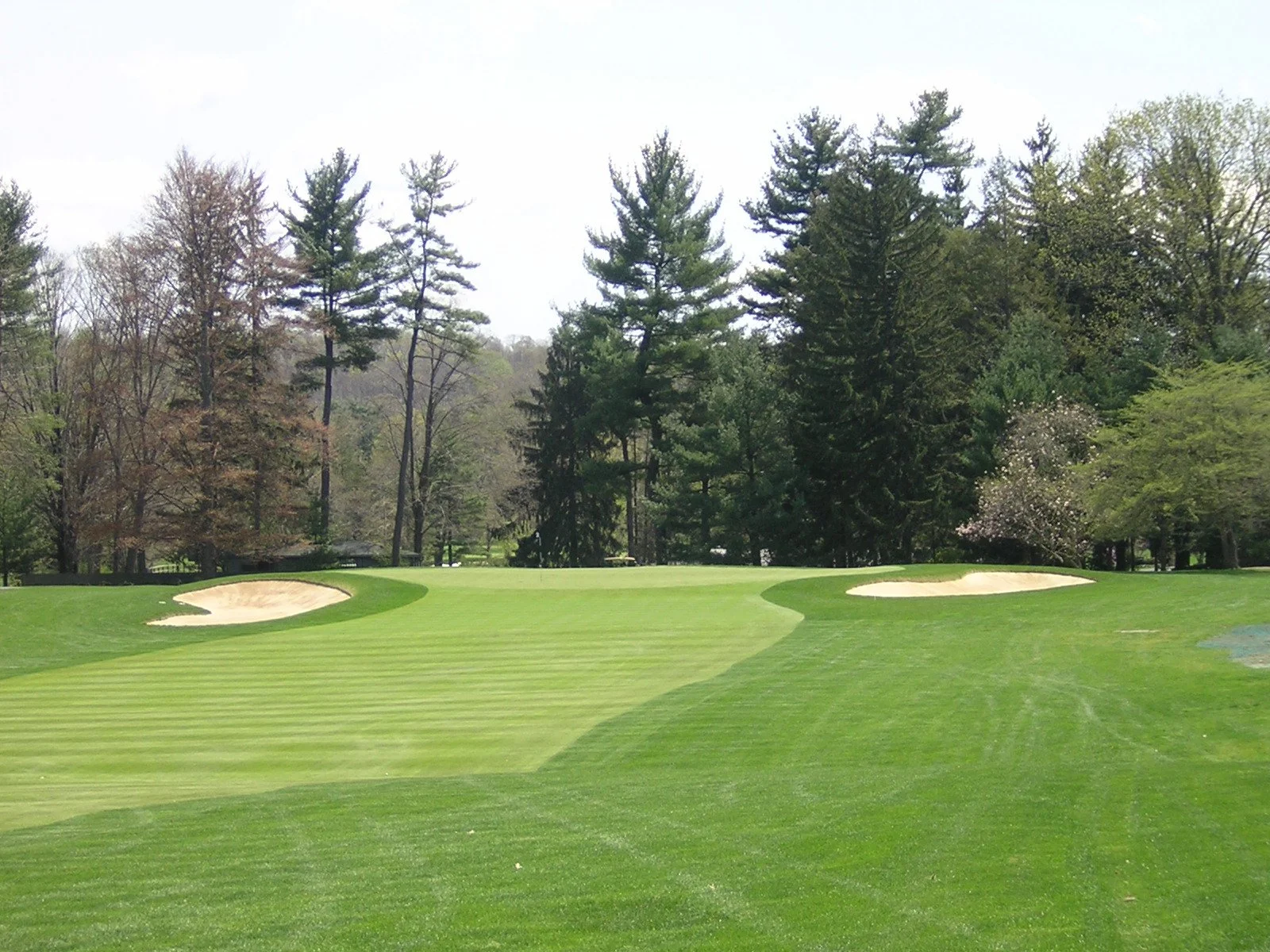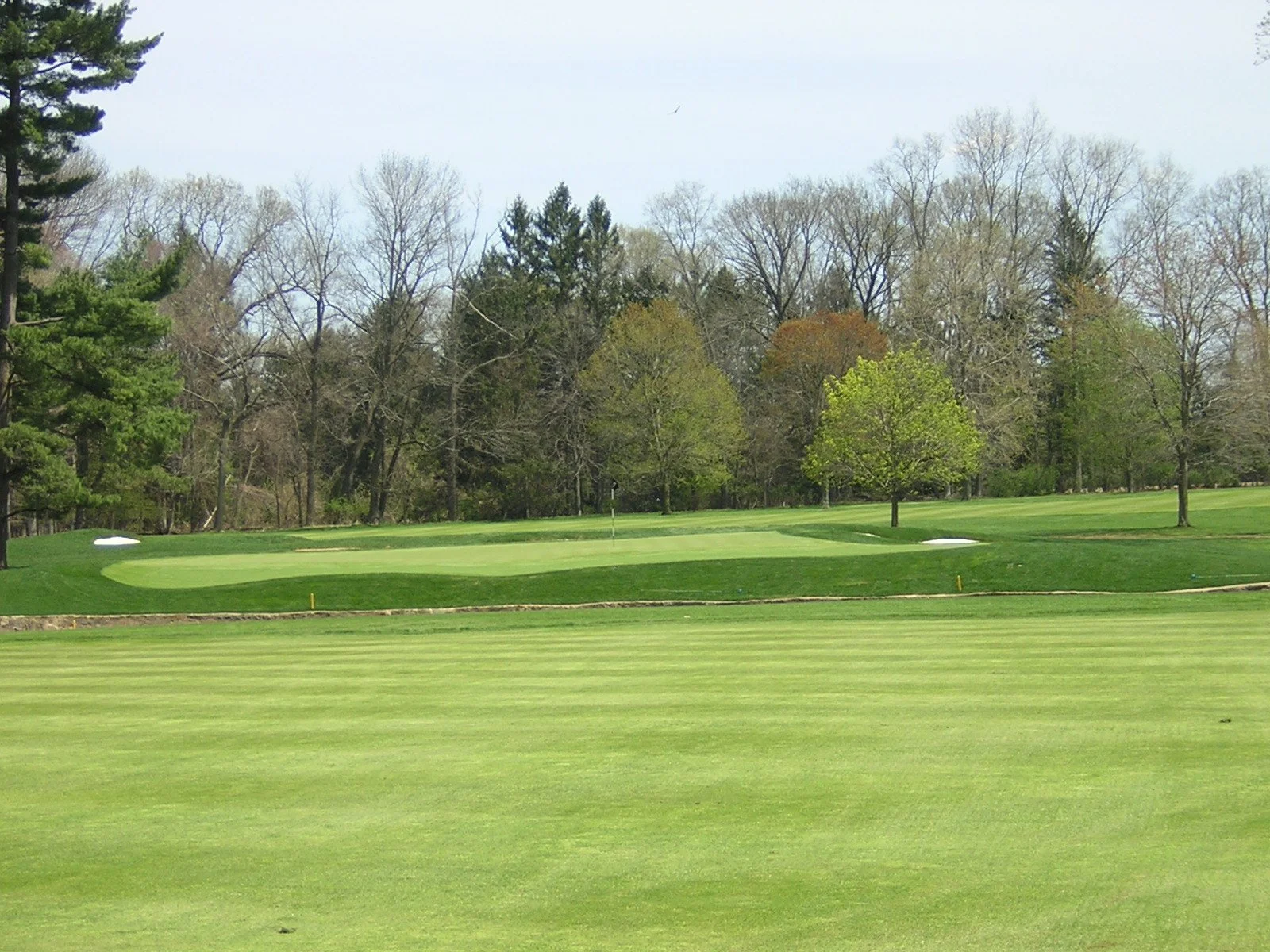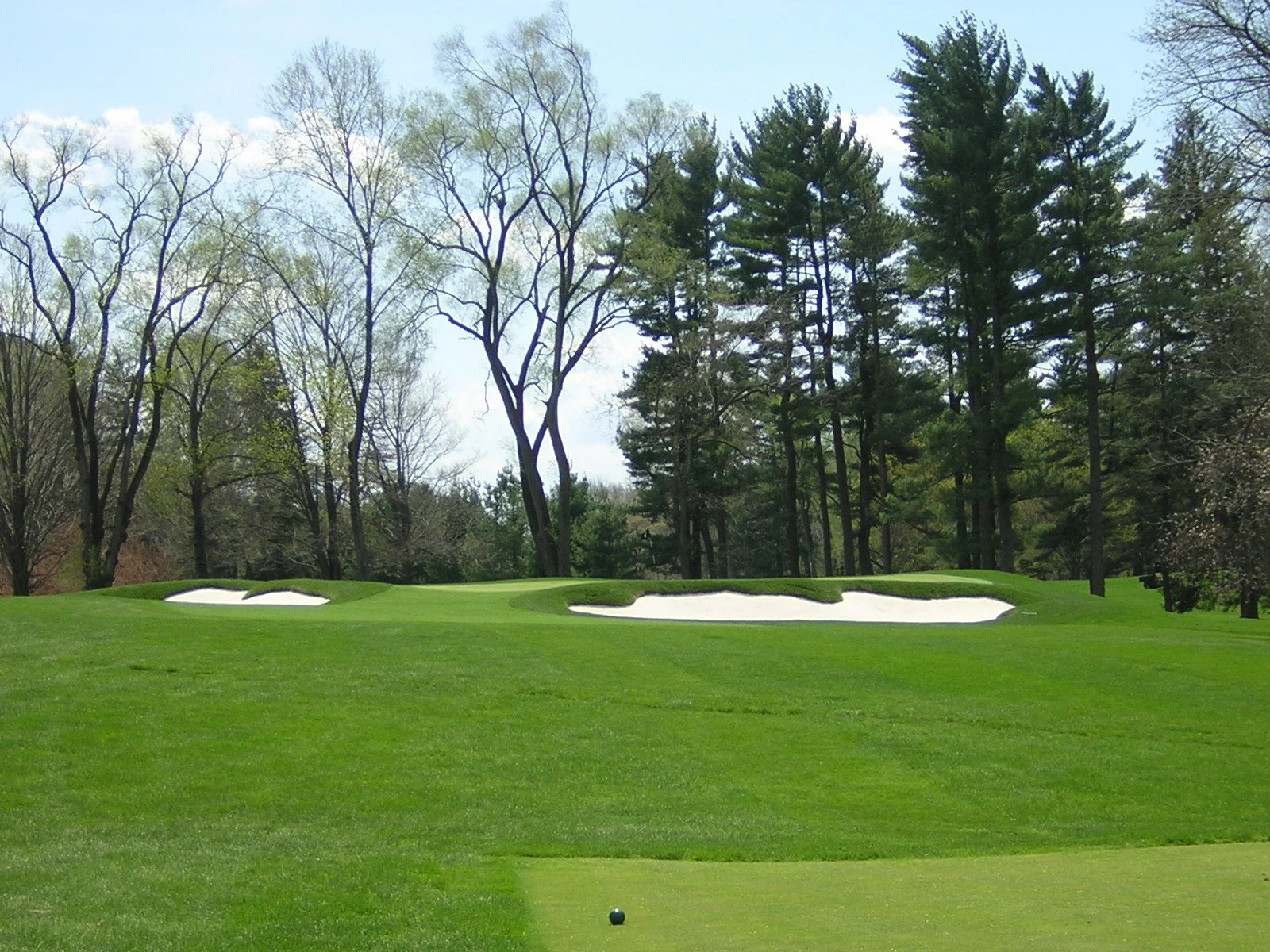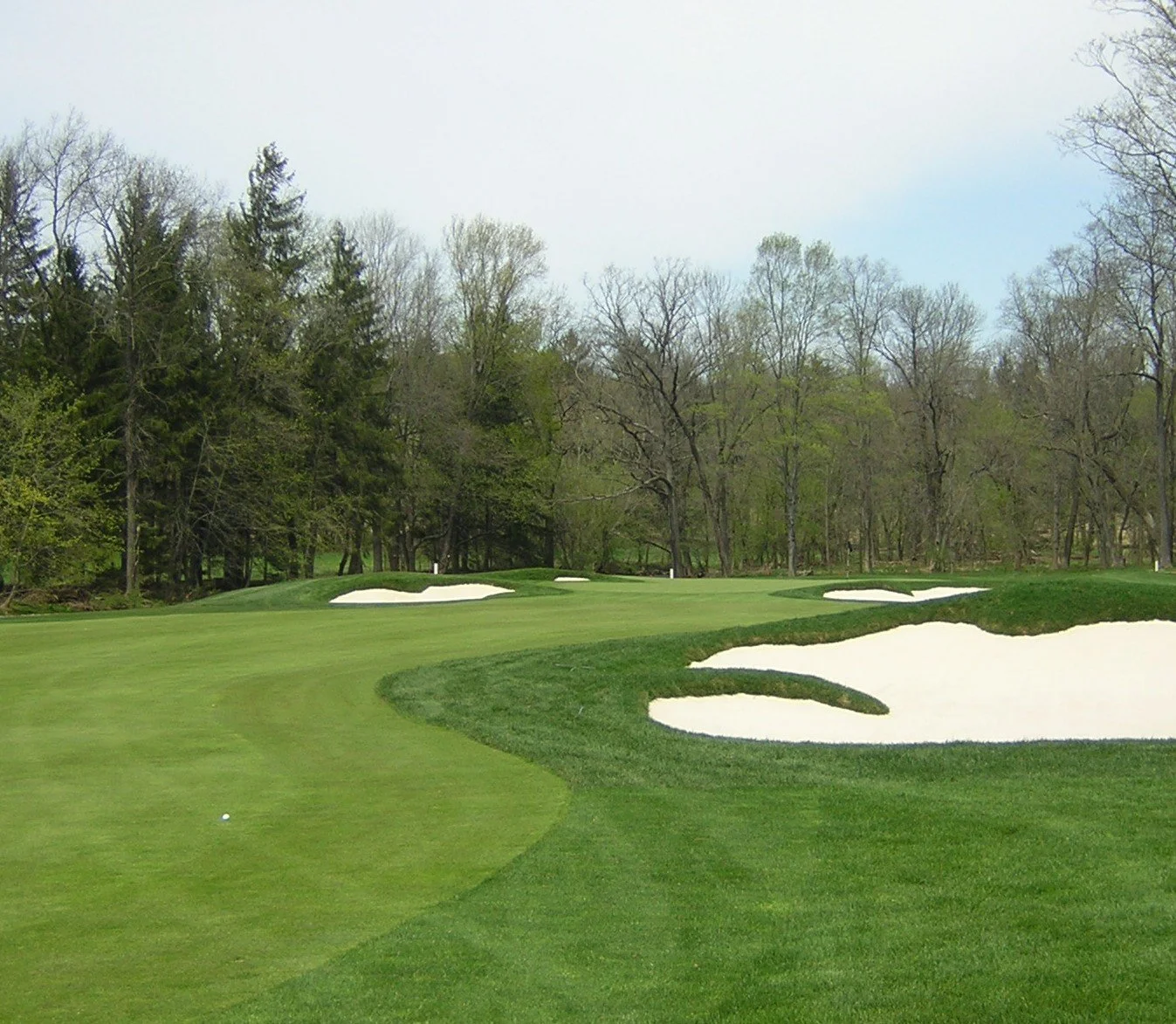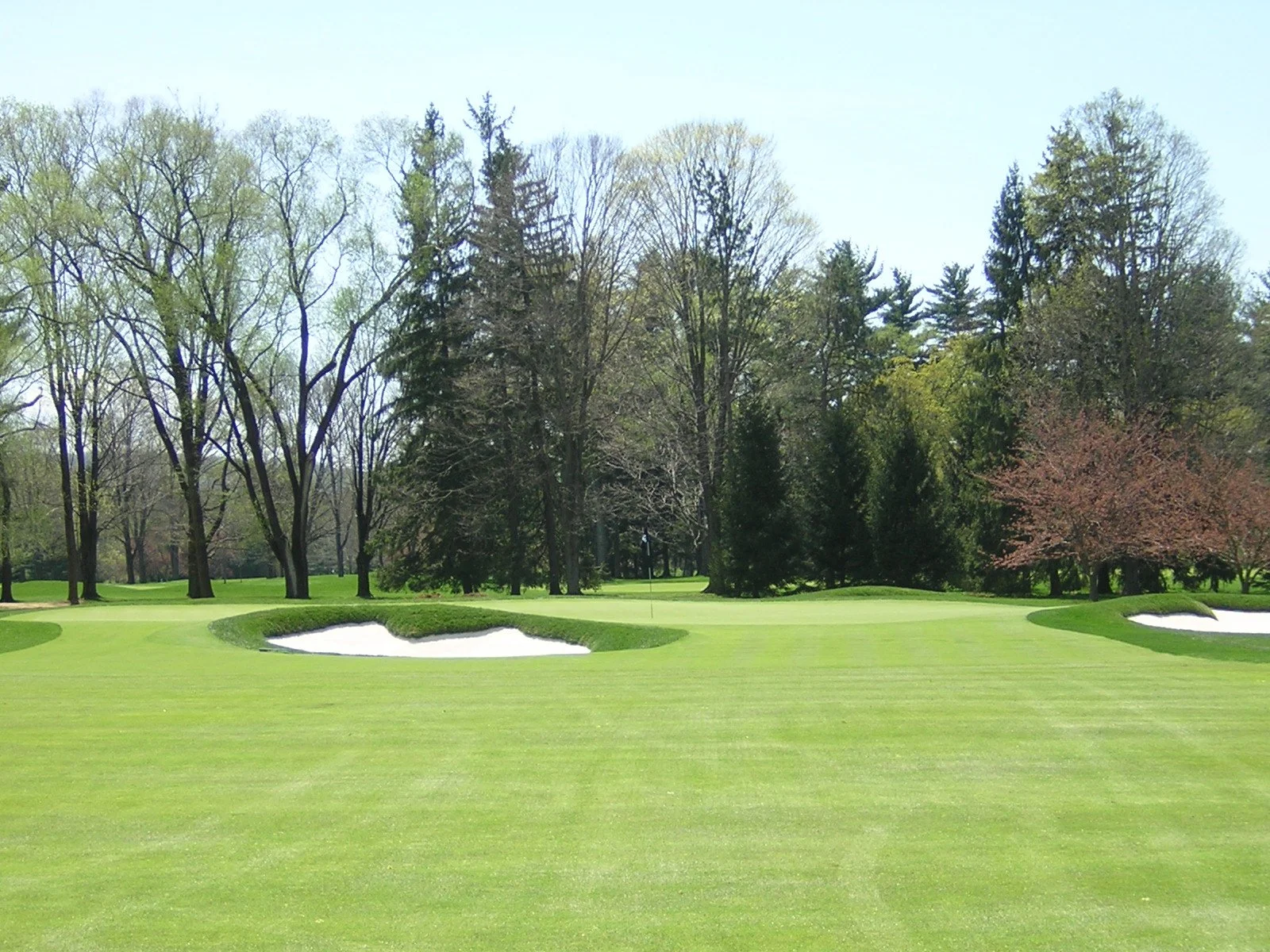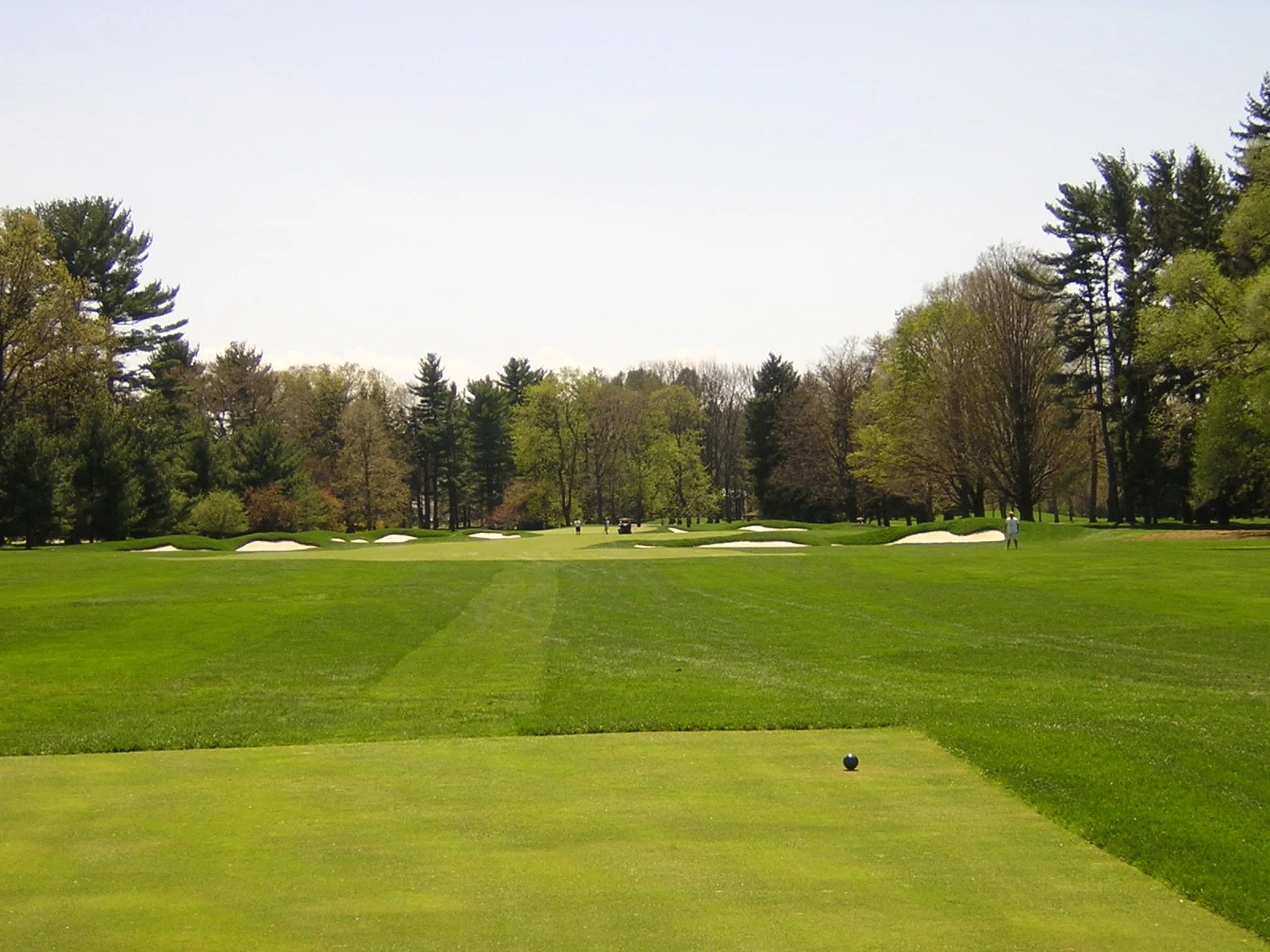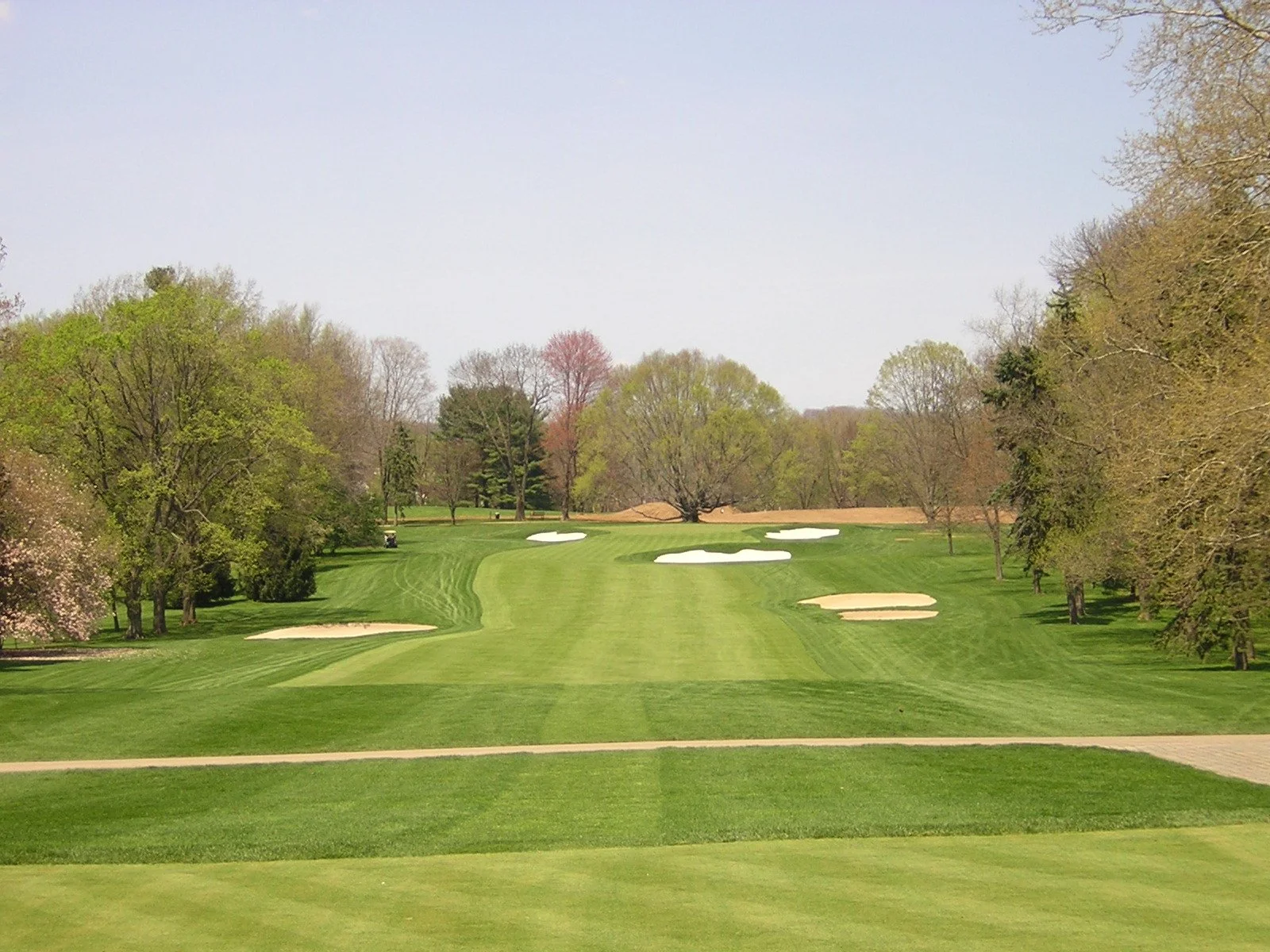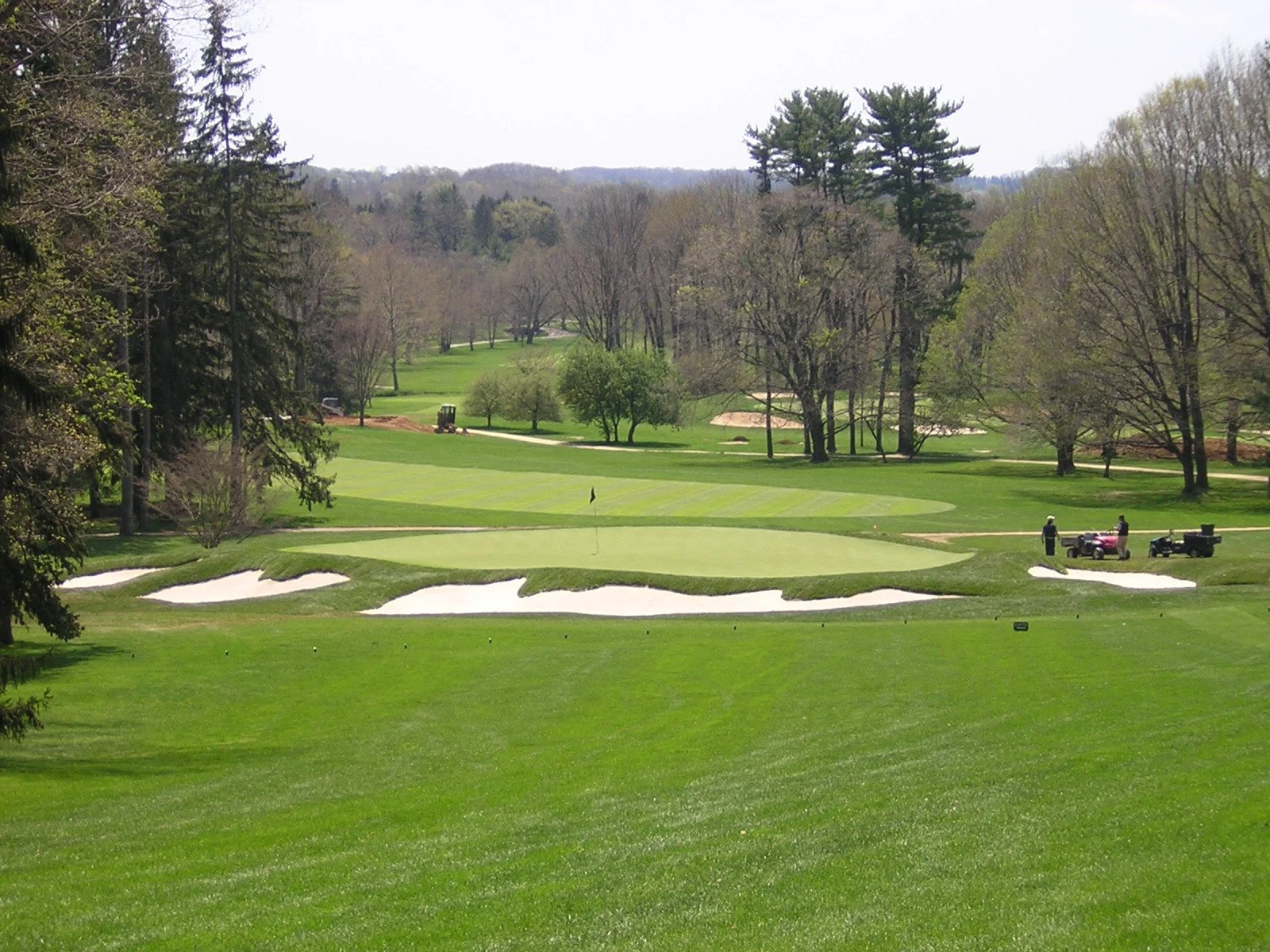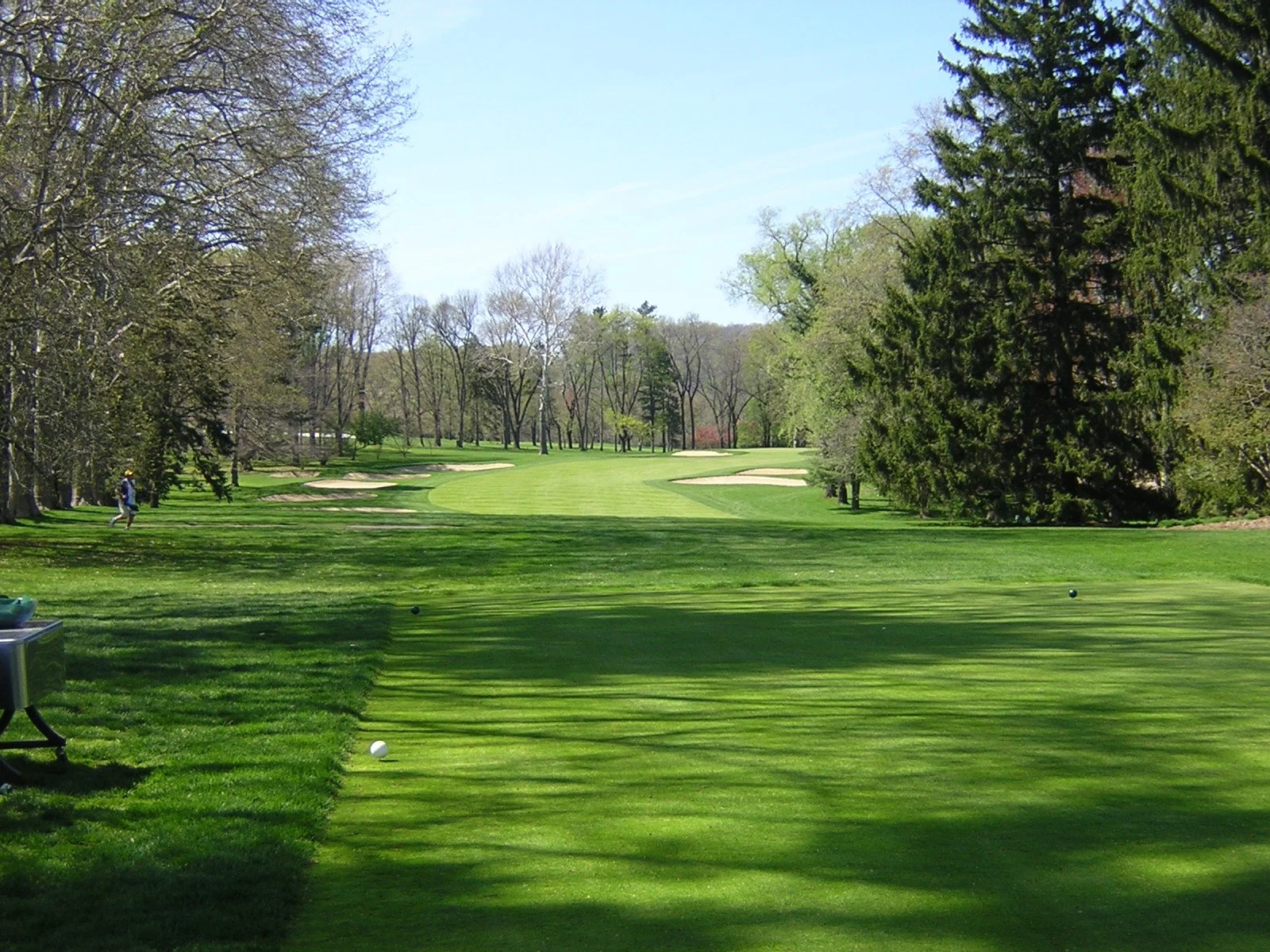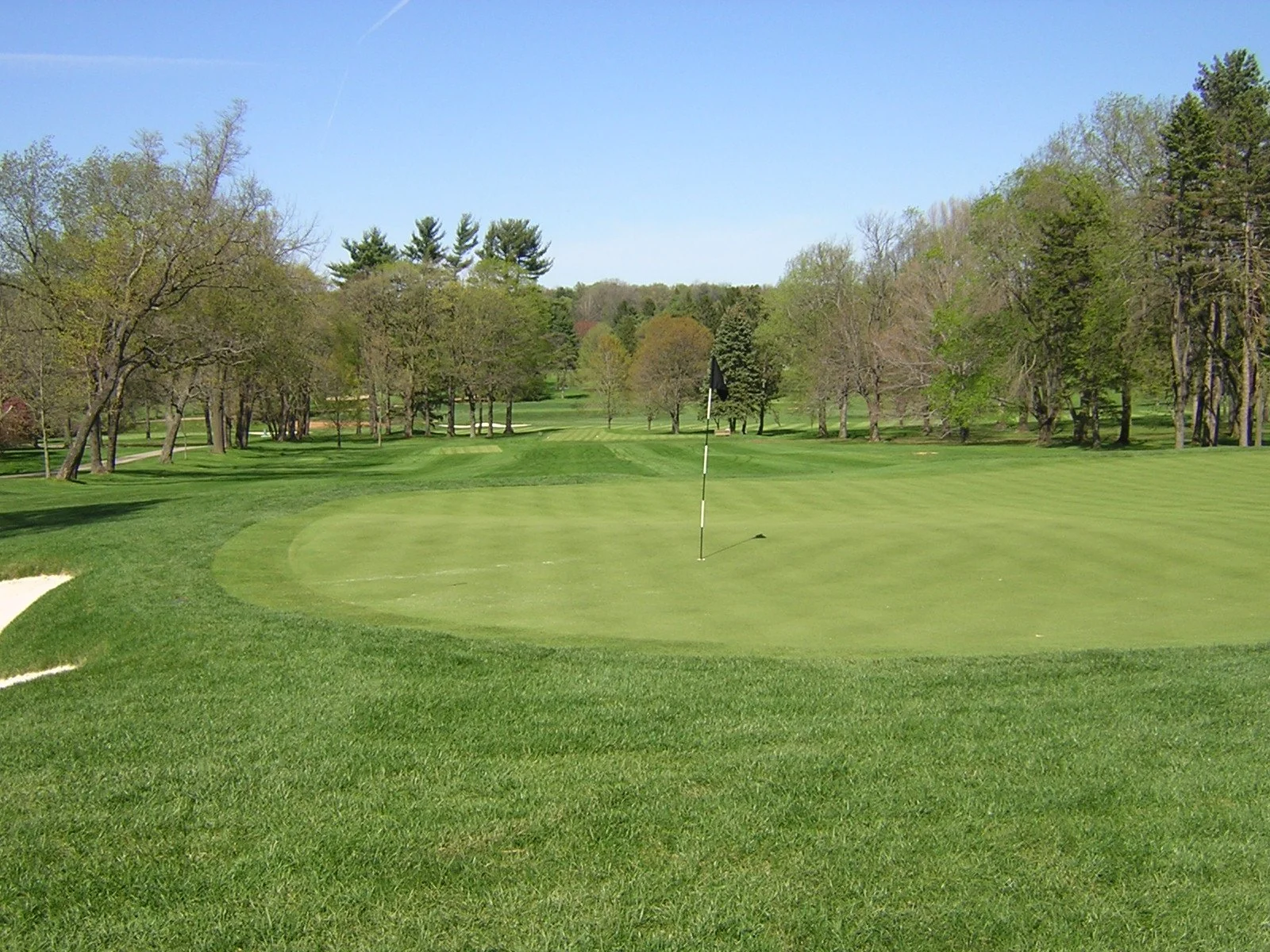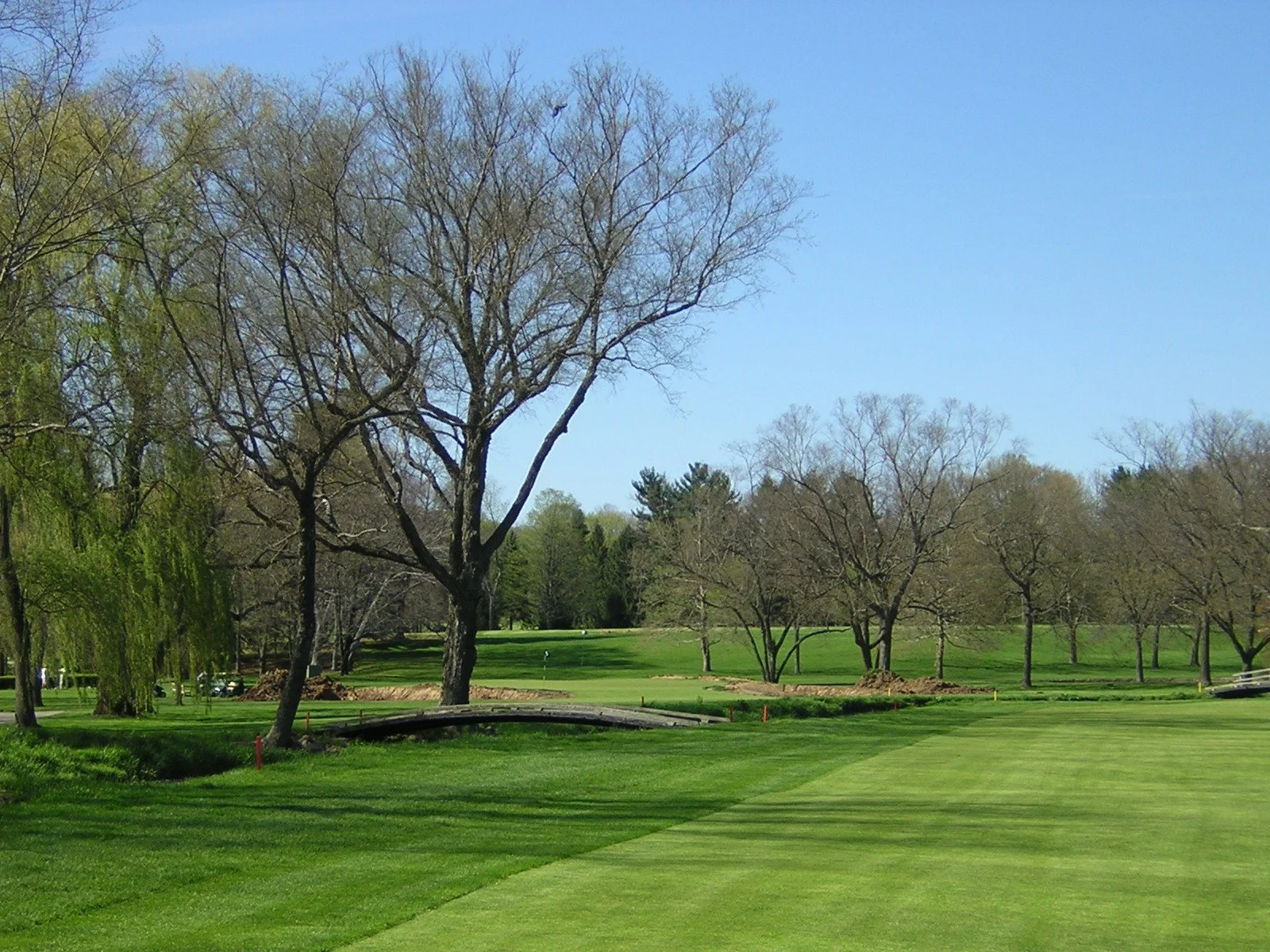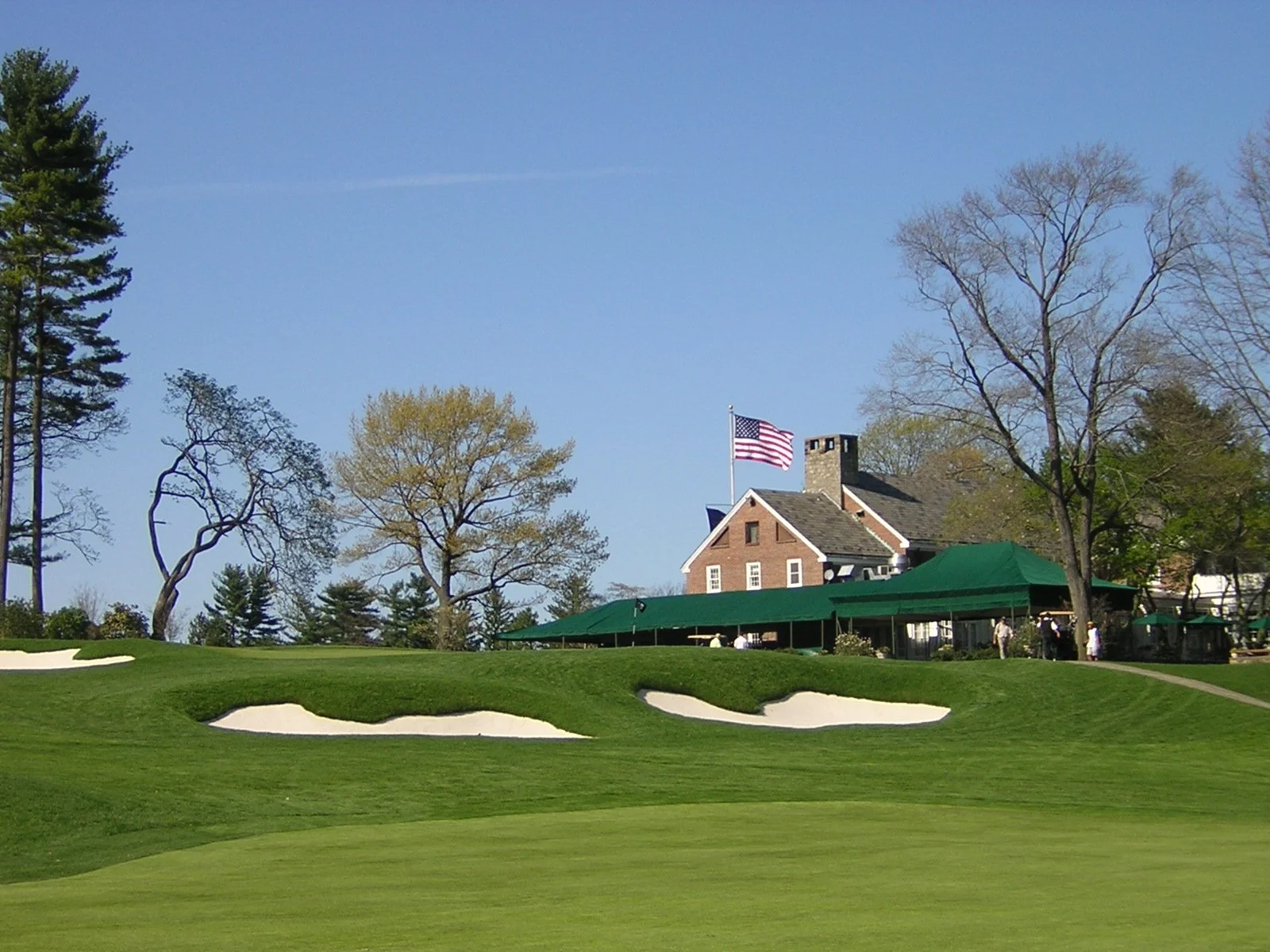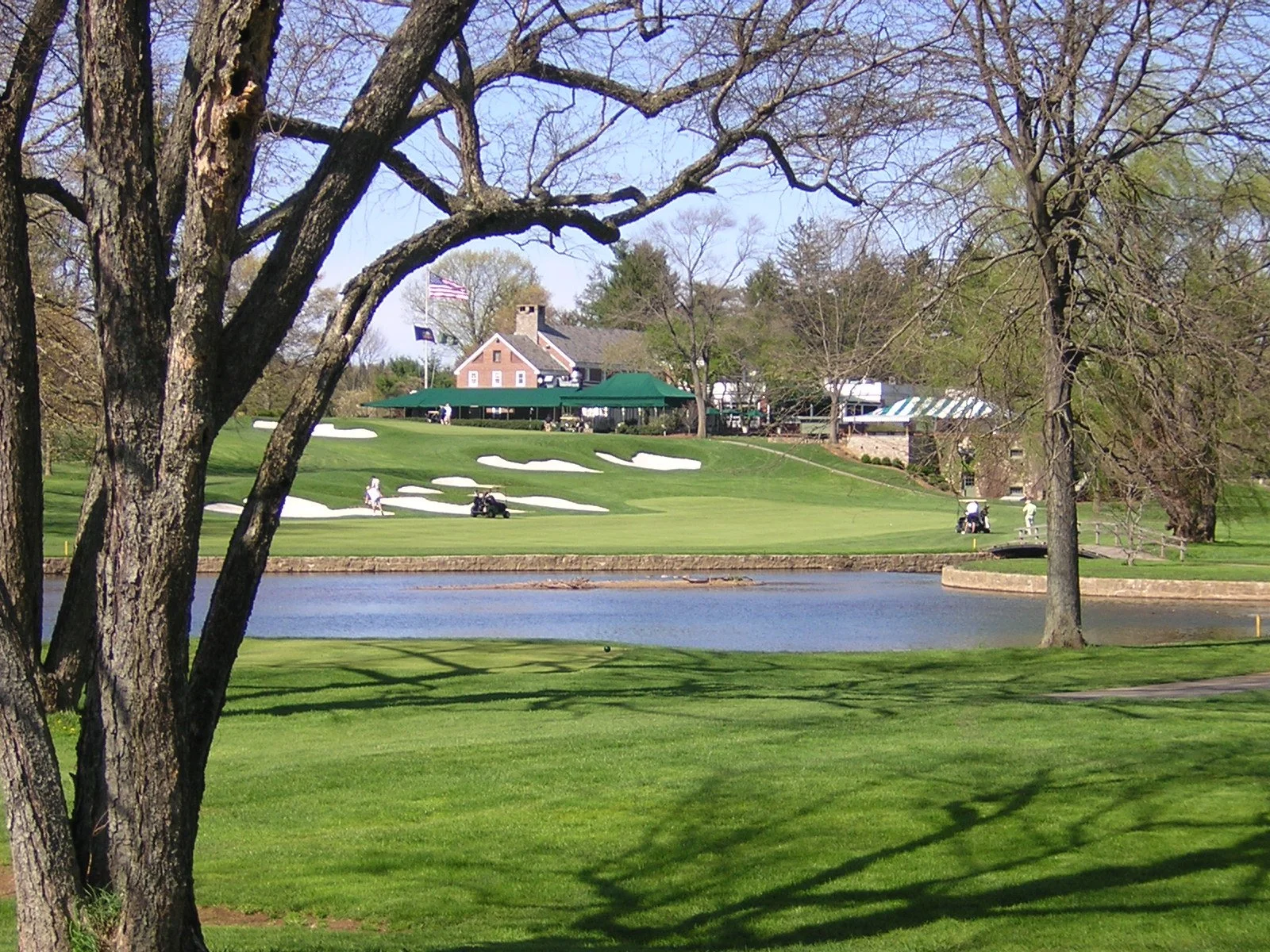SAUCON VALLEY COUNTRY CLUB (OLD COURSE)
Course Architects: Herbert Strong (1920-21), Eugene Grace, William Gordon,
Perry Maxwell (1941), Tom Fazio design (2005-08)
Year Opened: 1922
Location: Bethlehem, Pennsylvania
Slope: 142 Rating: 74.9
Par: 71
Yardage: 7,123
Hole-by-Hole: 1 - Par 5 558 Yds 10 - Par 4 387 Yds
2 - Par 4 474 Yds 11 - Par 3 172 Yds
3 - Par 4 368 Yds 12 - Par 4 435 Yds
4 - Par 3 159 Yds 13 - Par 4 338 Yds
5 - Par 4 480 Yds 14 - Par 3 192 Yds
6 - Par 5 582 Yds 15 - Par 5 615 Yds
7 - Par 4 456 Yds 16 - Par 4 496 Yds
8 - Par 4 429 Yds 17 - Par 4 422 Yds
9 - Par 3 215 Yds 18 - Par 4 345 Yds
Par 36 3,721 Yds Par 35 3,402 Yds
Key Events Held: U.S. Amateur (1951, 2051), U.S. Women’s Amateur (2038),
U.S. Junior Amateur (1983, 2026),
U.S. Senior Amateur (1987),
U.S. Senior Open (1992, 2000, 2022, 2032, 2042),
U.S. Women's Open (2009),
U.S. Mid-Amateur (2014).
Awards Won: Ranked #8 by Golf Digest - Best-in-State rankings (2005-06),
Ranked #9 by Golf Digest - Best-in-State rankings (2007-08),
Top-10 ranked by Golf Digest - Best-in-State since rankings began,
Audubon International Cooperative Sanctuary.
Website: sauconvalleycc.org
HISTORY: The club dates back to 1920, when a group of 16 businessmen from Bethlehem, Pennsylvania purchased a tract of farmland, 205 acres in all to inaugurate a full-service country club, with family being of the utmost importance. Most of the group of leaders were from nearby Bethlehem Steel Corporation, led by Eugene Gifford Grace. President of BSC for 30 years, Grace was known as the "Patriarch," of Saucon Valley, although he never held an official title at the club.
Grace selected well-known Herbert Strong to design the original course, then called the Saucon Course. Strong, who crafted Engineers Golf Club (NY), Canterbury Golf Club (OH) and Le Manoir Richelieu (Canada) to name a few, was originally from England and came to the United States in 1905. Strong, a former golf professional at Apawamis Golf Club in Westchester, New York, crafted a course that required positioning off the tee and well-thought approaches to severely contoured greens.
Completed in 1921, the course opened for play in June of 1922. Relatively wide open when first designed, over 4,000 trees were added in 1930. Over the years, the course has been tweaked by notable architects William Gordon and Perry Maxwell and just recently by the Tom Fazio Group.
The name Saucon Valley comes from the Indian phrase, "Sa-ku-wit," which means "the mouth of the creek." Saucon Creek, which runs through the property is a branch of the Delaware River.
When the club first opened, the active membership was limited to 500, which included 250 Charter members, with a initiation fee of $50.00 plus a 10 percent war tax. Evolving over the years, Saucon Valley Country Club now boasts 60 holes of golf and 1,000 members.
The Old Course at Saucon Valley has hosted some very prestigious events of the years. The United States Golf Association made its first stop at SVCC in 1951 for the U.S. Amateur Championship. In a field that included Ken Venturi, Gay Brewer, Dow Finsterwald, William Hyndmann III, P.J. Boatwright, Jr. and William Turnesa, Billy Maxwell, a virtual unknown from Texas came away with the title. Maxwell, just 22 years old, defeated Joseph Gagliardi, 4 & 3. After posting close victories in his first five matches, Maxwell crushed J.C. Benson, 10 & 9 in the semifinals before prevailing over Gagliardi.
Thirty-two years later, the USGA returned to the Old Course for the U.S. Junior Amateur, as Tim Straub, the runner-up from the year before, defeated John Mahon 1-up. Straub, from New York, defeated Bob Estes in the quarterfinals, 4 & 2, as he played the final 11 holes even par. During the championship match, Straub struggled early, making bogeys on four of the first
seven holes, however he led 1-up. Trailing on the final nine, Mahon holed a 50-foot putt for birdie on the 15th, only to have Straub match it with a four-footer. Two down with only two holes remaining, Mahon made par to close to within 1-down, however Straub made par on the last to win match.
The U.S. Senior Amateur Championship made its presence felt at the Old Course in just four years later, as medalist John Richardson defeated James Kite Jr., 5 & 4. With the win, Richardson became the first medalist since 1981 to capture the Championship in the same year. Richardson's play was impressive, as he held a 4-up lead after nine holes and increased it to five following a birdie on 12. During the first round of match play, Frank Tenfel defeated William Ludwig on the 25th hole, the second longest match in U.S. Senior Amateur history.
The U.S. Senior Open made the first of three appearances at Saucon Valley in 1992, as Larry Laoretti bested Jim Colbert by four shots for his only win on the elder circuit. Dave Stockton and Jack Kiefer shared the opening-round lead after shooting four-under-par 67s. Laoretti trailed by one shot, but his second round 72 placed him seven shots behind Stockton, who fashioned a
championship low 133. After shooting 68, defending champion Jack Nicklaus was only five behind. Laoretti, celebrating his 53rd birthday, carded a four-under 67 on day three and took a one-shot lead into Sunday, as Stockton shot 77. Laoretti continued his brilliant play the final day, as he shot 68 for the victory. Nicklaus, who fell back on Saturday, shot 67 and tied for third with Al Geiberger, Gary Player and Stockton. Hall-of-Famers Lee Trevino and Arnold Palmer made the cut, but finished well back - Trevino (T-18) and Palmer (T-32). Playing in the final pairing, Laoretti led Geiberger by one shot and were tied after 11 holes, however a Laoretti birdie on the par-five 12th from two-feet and a bogey by Geiberger proved to be pivotal. Laoretti sealed the win with birdies on 16 and 18. Colbert made up for a rocky start and birdied four of his last 10 holes to place second. The win enabled Laoretti to become the fifth player to win the U.S. Senior Open in their first try.
In one of the most exciting U.S. Senior Open's, Hale Irwin captured the 2000 championship on the Old Course in record fashion. Bruce Fleisher opened the championship with a record-breaking 64, as he birdied eight holes to offset one bogey. Irwin stood two back after day one and four behind following Friday's play, as Fleisher equaled the mark by Laoretti in the 1992 U.S.
Senior Open. Fleisher continued his stellar play, carding 67 for a three-day total of 200, two clear of Irwin, who battled back with a 65. After opening the championship with a 72, Tom Kite made his presence felt, as he shot rounds of 65-66 to trail by just three. It took only one hole for the leaderboard to change on Sunday, as Irwin made birdie and Fleisher bogeyed and the two were tied. Irwin took the lead for good with birdies on holes four through six, while Fleisher rebounded with birdies on six and eight, but trailed by one. Irwin continued his hot play with two more birdies on 12 and 17 to record a three-stroke victory over Fleisher. Irwin, who captured the 1998 U.S. Senior Open, made 23 birdies in 72 holes, including 15 in his last 36 and set a new
championship record of 267, which still stands. Kite finished alone in third, five shots back, while Ray Floyd, one of just two players in the field to post four sub-par rounds (Fleisher the other) finished fourth. Dave Stockton, who contended in 1992, tied for sixth, while Larry Laoretti, the winner in '92, missed the cut. Jack Nicklaus, who opened the championship with three
consecutive birdies, could do no better than a tie for 21st.
In 2022, the Old Course hosted its eighth USGA Championship, the 42nd U.S. Senior Open, as Padraig Harrington recorded a one-shot victory over Steve Stricker. With the win, Harrington became the first player from Ireland to win this prestigious event. Trailing Harrington by eight shots heading into the final round, Stricker fashioned a six-under-par 65 compared with Harrington’s 72, but it was not enough. Harrington bogeyed holes 10 and 11, but played the final seven holes in one-under to secure the victory, including a three-foot par save on the last.
Over the past eight decades since its opening, Saucon Valley Country Club has employed just five Golf Professionals, an amazing feat in this day and age of job displacement. Current Director of Golf Gene Mattare has been on board since 1991.
In its infinite wisdom, the USGA has awarded Saucon Valley with five more championship events, including the 2032 and 2042 U.S. Senior Opens. In addition, the 2026 U.S. Junior Amateur, 2038 U.S. Women’s Amateur and the 2051 U.S. Amateur will be hosted by Saucon Valley.
“Saucon Valley Country Club and the Lehigh Valley have enthusiastically supported many USGA championships for women, men, juniors and seniors for more than 70 years and we are pleased to continue that partnership,” said USGA Chief Championships Officer John Bodenhamer. “With this agreement, Saucon Valley and its impressive three-course facility will continue to shape the state of Pennsylvania’s renowned championship history for many decades to come.”
REVIEW: The course opens with a roller-coaster par five, playing uphill and then downhill to the green. A robust 558 yards, it's the shortest of three par-five holes! With sand guarding the left side near the green, the putting surface is almost unreachable in two by most mortals, as the fairway slopes to the right. The sensible play is down the right, setting up a simple wedge to a green that cants from left to right. Hitting this well-guarded green can set up a makeable birdie try, but stay below the hole for your best chance.
The second hole is the first of seven par-four holes over 400 yards in length. At 474 yards, a long drive down the right should leave a mid-iron to a slightly elevated putting surface, that slopes hard to the front. Avoid the deep bunker to the left of the green and you'll have a shot at par. "Roadside" as it's called due to the proximity of the entrance of the club, is rated as the third most difficult on the course. During the 2000 U.S. Senior Open, the second ranked as the hardest hole during the championship.
One of the prettiest holes on the course, the third requires accuracy, as opposed to brawn. Fairway-metal or hybrid off the tee on this dogleg left, will leave a short-iron to a green protected by Saucon Creek in the front and sand right. Any play on the front of the green, will spin back towards the creek and possibly into the water, depending upon how shaved the chipping area is mown. The two-tiered green can yield birdies, but beware of the tough pin placements.
The first par three is also the shortest at 159 yards. Slightly uphill, the fourth features a well-guarded, double level green that slopes hard from back to front. Pin-point accuracy is key, as the surface is not very deep and the front and side bunkers get plenty of play. Long is no bargain either, as the green sits well above your feet.
With trees down both sides of the fairway, the fifth necessitates a straight drive. Long is also part of the equation, as the hole measures 480 yards from the tips. A medium- to long-iron will remain to the longest green on the course at 40 paces deep. Bunkers left and right protect the surface, while Saucon Creek is in play left of the green.
Aptly named "Sahara," the long par-five sixth features plenty of trouble in the form of sand. With a successful tee ball, your second shot is played over a large sandy expanse that must be avoided at all costs as it also protrudes down the right. The left side is the proper play to lay up, leaving just a
wedge to a well-guarded green. The pot bunker fronting the surface will make for a difficult up-and-down. It comes as no surprise that the sixth is the number one handicap hole on the course.
The straightaway seventh is a gem of a par four reaching 456 yards from the back tees. Sand juts out in the fairway down the right, while a pair of bunkers flank the left. The key is negotiating the green, as a huge slope in the center of the surface presents quite a dilemma.
One of several doglegs on the course, the eighth bends sharply left and requires a draw from right to left over the deep bunkers that guard the corner. A short- to medium-iron remains to a very accessible green with bunkers left and right. The putting surface however is quite the opposite, as the green features difficult contours. A back-right pin could produce some big numbers.
The only par three on the course over 200 yards, the ninth is one of the many signature holes at Saucon Valley. Playing over the meandering creek, a hybrid or long-iron is needed to carry the water and split the bunkers that protect the opening of the green. The putting surface is quite undulating, as it cants from back to front. As bad as short is on this hole, long can be worse, as OB
is nearby.
The back nine starts with a straightaway par four that plays uphill from the fairway. Bunkers on both sides of the landing area guard the tight zone. A medium- to short-iron remains to a two-tiered, long green with a trap on either side. Any shot above the flag will be next to impossible to get down in two putts. In fact, you'll be fortunate to keep the ball on the green. All of a sudden, a hole just 387 yards in length became not so easy.
One of my favorite holes on the course, the par three 11th plays downhill to a well-guarded green. A whopping seven bunkers surround the putting surface that features a swale in the rear-portion. A mid-iron should be the club choice, however when the wind blows, club selection is next to impossible. Par here is a good score.
Originally designed as a par three, the 12th is a dogleg-left par four that was changed by famed architect Perry Maxwell. The tee shot is critical, as it must be played with a slight draw to set up the best approach to the green. Any shot played without this shot-shape, will run through the fairway into sand or worse, deep rough. The putting surface is my least favorite on the course, as it is designed after the Biarritz style with a two-foot slope near the front of the green. Having said that, the hole, which will play as the 18th for the U.S. Women's Open in 2009, will provide a good test for any player.
Here's a great example of a short hole being just as difficult as a 450-yarder. Just 338 yards from the tips, the 13th is a dogleg right, tree-lined gem that requires pinpoint accuracy off the tee. A series of traps guard the left side of the fairway, while two more protect the right. Let's not forget
the trees lining both sides of the landing area. The putting surface is slightly elevated and guarded on both sides. If successful off the tee, just a wedge will remain, so you can attack, but that's a big IF.
Although under 200 yards in length, the 14th plays uphill from tee to green and necessitates a long-iron or hybrid just to reach the putting surface. Bunkers on both sides protect the promised land, which is quite slick and undulating. The green is multi-tiered and a back-right pin is very difficult to get at. The final one-shotter on the course completes an outstanding set of par threes.
The longest hole on the course, the dramatic 615-yard 15th sweeps downhill and right to left. Trees down the left side define the Saucon Valley layout, as they tower over the fairway. A solid tee ball down the right side is needed to set up your second-shot layup. Once again, down the right side is the play, avoiding the large fairway trap on the left. Just a pitch will remain to an undulating green that slopes from back to front and is guarded precisely by five bunkers. This hole can be had with three perfectly executed shots.
The only hole on the course without a trap, the 16th plays straightaway with Saucon Creek down the entire left side. Previously a pushover at 434 yards, this hole has been lengthened to a whopping 496 yards. Trees and thick rough are a very good substitute for sand and any shot offline from the tee will most likely make for a punch-out. A long-iron or hybrid to the green must be wary of the creek on the left, as it is meanders very close to the putting surface.
The final two holes on the Old Course are as good as it gets. With the creek down the left side and cutting in front of the green, the 17th is not only difficult, but quite picturesque. At 422 yards, it's certainly no routine par. Along with water, trees down the left side can block out the green, even if you're in the fairway. So play down the right side to set up the best angle to the putting surface. Sand guards the green, which is one of the easiest on the course. Making par here is no small task.
Spectacular. That's the best word to describe the finishing hole. A mere 345 yards, the 18th requires an accurate tee shot and an even more precise second. Just a fairway-metal or long-iron is required off the tee. The key here is avoiding the series of bunkers down the left and water and rough down the right. This is where it gets dicey, as your approach with just a short-iron, is played dramatically uphill to a radically quick green that slopes hard from back to front. The putting surface is barely in view from the fairway. Most visible are the three fronting bunkers and the Georgian-style clubhouse in the rear. Quite a site.
FINAL WORD: The best way to describe the Old Course at Saucon Valley is "Classic." From its rolling fairways, to well-manicured greens and tees, the Old Course is as elegant and genuine as they come. The Old Course is so revered, that the USGA has rewarded the club six times to host its prestigious events.
Since day one, the Old Course has been a work in refinement. From the brilliant layout by Herbert Strong, to the restoration work of Tom Fazio and company.
Saucon Valley Country Club is not just golf. It's 850 acres of tennis, squash, swimming and of course, 60 holes of amazing golf. The Old, Grace and Weyhill courses, along with the six-hole short course, make up some of the finest golf in the region. In fact, both the Old and Grace courses have been rated in the top-100 by Golf Magazine, one of just three private clubs in the United States to share that honor (Baltusrol and Winged Foot).
The golf itself is superb. It doesn't get much better than the beautiful third, or the massive sixth, or the sensational ninth or those two great finishing holes. The Old Course requires brawn, strategy, accuracy, finesse and most important, thought. If you expect to move around the course with ease, you're mistaken. Look what happened in 2000, when the best players of the over 50 crowd came to town. The average score was a whopping 74.101!
If you get the chance to tee it up on the Old Course, you might not be happy with your final score, but you will most certainly revel in the thought that you just played one of the finest venues on the east coast. Former USGA Senior Director of Rules and Competitions, Mike Davis calls the Old Course, "A wonderful test of golf. A balance of long and short holes with wonderfully contoured greens." He hit it right on the screws.
Just sit back on the veranda of the magnificent clubhouse, pull back a cold one and enjoy the moment, it's worth remembering.


